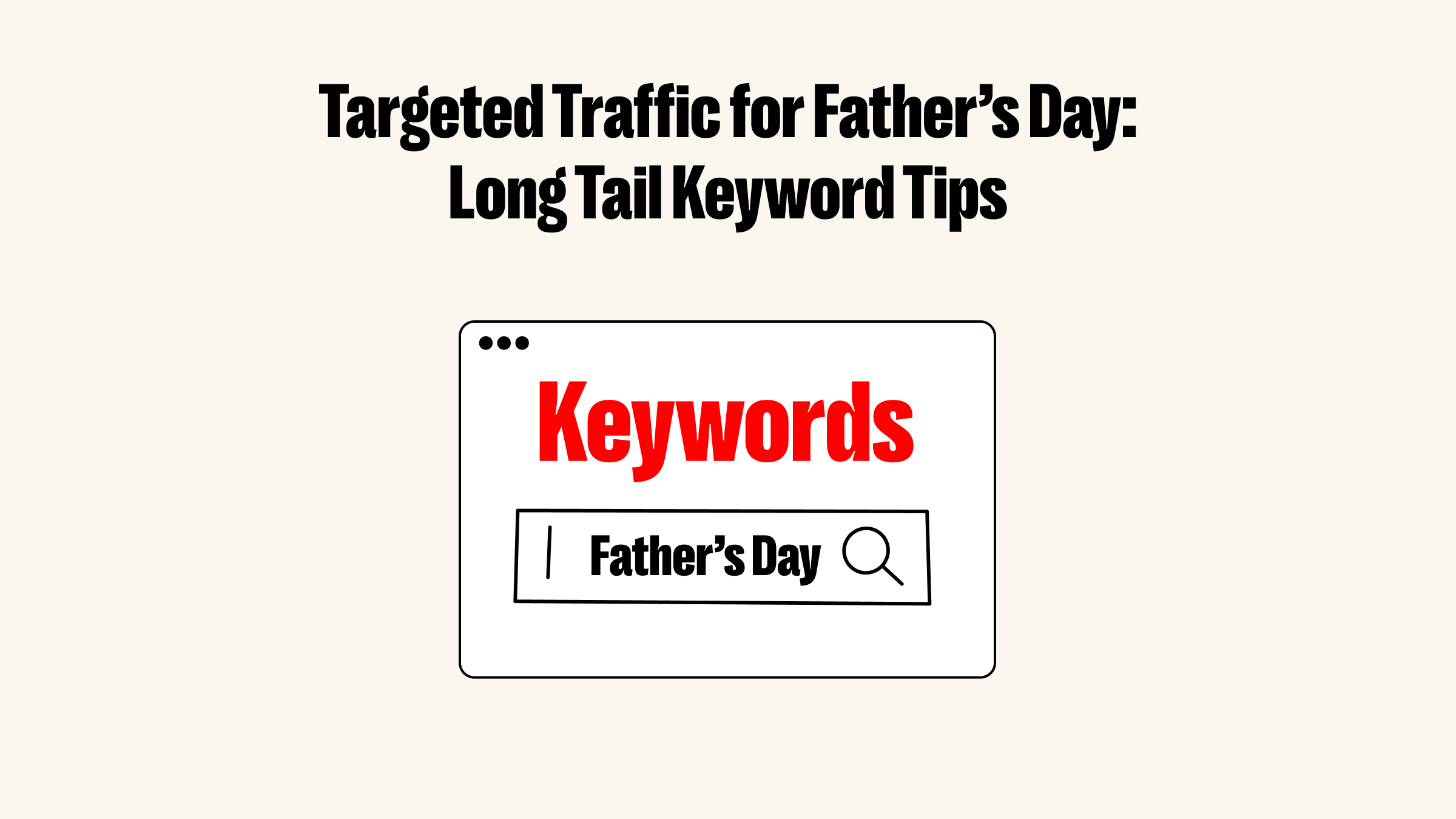Every year as Father’s Day nears, both paid ads and organic listings get flooded—but only a few truly convert. What makes the difference? Specificity. Pages that target real buyer intent stand out. If you want to bring more targeted traffic to your website, long tail keywords can make all the difference. In this blog, we’ll walk through practical tips to find, use, and refine them—just in time for Father’s Day campaigns.

What are long tail keywords and how do they work?
Long tail keywords are specific search phrases, usually 3–5 words long, with search volumes under 300 and keyword difficulty (KD) below 30 (Metrics may vary by industry). Instead of targeting broad, generic, and high-competition terms like “father’s day gifts,” a more refined version might be “unique stroller organizer for first-time dads.” These keywords are characterized by:
-
Lower competition with faster SEO results: Long tail keywords reside in the quieter corners of search engine results pages. You’ll rank faster and more easily. Even better?
-
Higher conversion rates through specific intent: Searches like “personalized BBQ tools for father’s day” show that they’re not here to kill time and they have strong buying intent. These precise phrases reflect a deeper decision-making stage.
-
Better ROI for SMEs and niche websites: Lower cost per click, more qualified leads, and less budget wasted on irrelevant impressions.

Actually, they work by matching your content with shoppers who already know what they want. Not casting a wide net, they target users or niche audiences with clear intent—often near the point of purchase. This precision boosts your chances of ranking in search results, attracting more qualified traffic, and converting browsers into buyers.
Why use long tail keywords to get targeted traffic?
So—are long tail keywords better than short tail keywords? When it comes to reaching the right audience at the right time, the answer is a resounding yes. Let’s break it down.
Short tail keywords (like “backpack” or “coffee mug”) attract massive search volumes but come with sky-high competition and unclear intent. Is the person searching “coffee mug” trying to buy one, find design inspiration, or research ceramic materials?
In contrast, long tail keywords cut through ambiguity. Behind every purchase is a mental journey: one that starts from a general idea and narrows into a focused scenario. For example:
-
General need: It’s almost Father’s Day, and I want to buy a gift.
-
Defined context: My dad is a retired fisherman who loves quiet mornings.
-
Decision point: I need something under $50 that’s practical but memorable.
This evolution in thinking is perfectly mirrored in long tail searches. Take anoter example, “gift for new dad from wife.” The person behind this phrase isn’t browsing aimlessly. She’s a new mom, eager to honor her partner with something heartfelt. She’s not swayed by top-ten lists—she’s looking for emotional relevance.
So, while others fight over “father’s day gift,” a wise marketer quietly wins orders with “gifts for dads who like to read” or “funny gifts for introverted fathers.” Less noise. More conversion.
Where to find high-quality long tail keywords?
Once you understand the value of long tail keywords, the next step is knowing where to uncover high-quality ones that truly match your audience’s search intent.
Free long tail keyword research tools
Google Autocomplete is a goldmine. You can type in a root term and watch the suggestions unfurl. These Google long tail keywords are based on actual search behavior. Also, you may find more from “People Also Ask” and “People Also Research for” to expand your keyword web effortlessly.

AnswerThePublic turns basic terms into semantic gold. While the free version limits daily searches only 3 times, it’s perfect for brainstorming content ideas, blog topcis, and FAQs.

Soovle aggregates search suggestions from Amazon, YouTube, Bing, and more—ideal for diversifying keyword sources, though it lacks data on search volume or competition. It is recommended for beginners and small cross-border sellers as a low-cost way to gain hands-on experience.

Keyword Tool offers free keyword suggestions, though in-depth data requires a paid plan. You may use it to verify your keyword groupings and popularity.

Ahrefs free keyword generator tool is perfect for quick checks. It offers keyword ideas across Google, Bing, Amazon, and YouTube with metrics like search volume and difficulty.

Paid tools for deeper keyword research
For those ready to dig deeper, Ahrefs and SEMrush are powerhouse platforms. The Keyword Magic Tool on SEMrush, in particular, filters long tail gems by volume, difficulty, match type, and more. For instance, if you want to unpack “gift for retired dad”, you can sort by low-difficulty, high-intent terms and immediately identify opportunities your competitors missed.

One of the smartest moves? Study the competition. Tools like Ahrefs’ “Content Gap” and SEMrush’s “Keyword Gap” reveal the phrases others rank for—but you don’t. These often include untapped long tail keywords with clear potential.

3 steps to long tail keywords for Father’s Day marketing
Once you know where to find strong long tail keywords, the next step is putting them to work. Here are 3 steps to help you win targeted traffic to your website.
Find good long tail keywords
Let’s say you’re gearing up for Father’s Day. Many sellers zero in on the obvious: “father's day gift.” But did you know that keyword racks up over 831,000 global searches, with 181,000 in the U.S. alone? Its SEO difficulty sits at 38 out of 100—steep. Ads on that term? Expensive and oversaturated.

A smarter route: rethink the “father” label. What does it really mean? To know how to find long tail keywords for SEO, you need to move beyond broad terms and zoom in on real and specific intent. Ah! You should segment types of dads; in a word, think about the identity of various "fathers":
-
Recently retired
-
Loves camping
-
Quiet bookworm
-
New father learning the ropes
-
Soon-to-be father-in-law
……
You can just pair roles with scenarios to form or select "high-intent keyword combinations", and type it to keyword tool for examination. Here's how some solid long tail keywords break down:
| Long Tail Keyword | Search Volume (US) |
Difficulty (/100) | Ideal Use |
| gifts for retired father | 70 | 21 | Collection page, blog |
| gift for retired dad | 590 | 16 | Collection page, blog |
| gift for new dad from wife | 210 | 25 | Collection page, blog |
| gifts for dads who like to read | 20 | 0 | Product page, blog |
| gift for father in law | 1300 | 26 | Collection page, blog |
| gag gifts for father in law | 40 | 18 | Collection page, blog |
| father's day gifts for 60 year olds | 30 | 26 | Product page, blog |
Many of the keywords above work especially well for collection pages. For example, a “gift for new dad from wife” page could feature practical or sentimental items like a diaper bag, baby carrier, or a first-time dad book—all themed around fatherhood and function.
To go deeper, you may break down your audience by age. Someone searching “father's day gifts for 60 year olds” likely has retirement, health, or nostalgia in mind. Similarly, targeting “for 40 year olds,” “for 50 year olds,” or “gifts for grandpa turning 80” taps into generational preferences and increases buyer intent.
Budget is another key filter. To help users with different spending power, you can add sections in product pages or write blog topics for price-specific ideas like “Father’s Day gifts under $50” or “gifts under $100 for him.” These make it easier for buyers to commit without hesitation.
But be cautious—broad search terms like “top father's day gift” or “best gift for dad 2025” might seem promising but are dominated by major content sites and review bloggers. High ad competition and SEO difficulty make them risky, especially for new sellers.
Therefore, instead of chasing volume, focus on product uniqueness, use-case, and niche demand. For example:
-
gift for dad who love fishing
-
gifts for dads who like to read
-
gift for retired dad with bad knees
-
gifts for future father-in-law from bride-to-be
Each of these long tail keywords reflects a real-life scenario. You’re not just selling a “father’s day gift”—you’re offering a thoughtful solution tied to a specific person, relationship, or lifestyle.
Use them in your content strategy [tips + examples]
Now, it is time to learn how to get free targeted traffic to your website with found keywords. Long tail keywords are your ticket in—but only if you use them correctly. Here’s the formula:
? Focus each page on one primary long tail keyword
? Add 3–5 related keywords for context
? Insert keywords into the page title, meta title, meta description, H1-H3 titles, body copy, and image alt text
? Reinforce them in FAQs, testimonial quotes, and structured data
|
Example:
? Product Title:
“Best Fishing Pole Gifts for Retired Dads Who Love the Water”
?? Covers “gift + fishing pole + retired dad” with emotional resonance.
? Meta Description:
“Surprise your retired dad with a lightweight, easy-to-use fishing pole he’ll love. Perfect Father’s Day gift for dads who enjoy calm days by the lake.”
?? Highlights usability (lightweight, easy-to-use), application (by the lake), targeted user (retired dad), and user lifestyle (enjoy calm days).
? Image Alt Text:
senior-dad-using-lightweight-fishing-pole.jpg
father-fishing-at-lake-with-gift-rod.jpg
?? Visually descriptive, keyword-rich with “gift/fishing/dad”.
|
In this way, your content will be more compelling and laser-focused. If you're not confident in your copywriting skills, you can use the built-in AI optimization tool from Shoplazza to boost your content quality. Just provide the following:
1?? Product’s key features, target customer profile, and keywords
2?? Word count (generally under 200 words is enough)
3?? Preferred language (e.g., English, German, French, Portuguese, Spanish, etc,.)
4?? Tone of voice (e.g., warm, humorous, formal)

To go even further, you may try pairing your website with an SEO Optimizer plugin. It can really boost how your pages show up on Google. Here’s what it can help you with:
1?? Tidy up image ALT tags (so instead of “image01.jpg,” you’ll have something like “retired-dad-fishing-gear.jpg”)
2?? Check if your meta setup is complete for product pages, your homepage, blog posts, and collection pages
3?? Auto-optimize meta tags so you don’t have to write them from scratch
4?? Generate a sitemap to keep your site structure Google-friendly
5?? Set up page indexing rules (like noindex or nofollow) to control how your content gets crawled—and help improve your click-through rates

With clear themes, strong long tail keywords, and the right tools, you’re setting your pages up for better rankings—and more clicks from shoppers who are ready to buy.
Monitor and optimize them
Even the best long tail keyword strategy isn’t a one-and-done deal—it’s a process that needs regular check-ins and smart tweaks. After all, how to get targeted traffic consistently comes down to how well you respond to real data.
One of the most practical tools for website traffic? The “Search Term Detail” Report in your Shoplazza dashboard. It shows you:
?? What keywords users are typing in your store
?? How often each keyword gets searched and clicked
?? Which terms lead to page views, add-to-carts, or conversions

Every 2–4 weeks, you should export the report and track changes over time. Here’s what to look for:
?? If a keyword has 0 clicks for 2-3 weeks straight, it might not match how your audience actually searches. You may consider tweaking or removing it.
?? If a keyword gets searches but low clicks, it could mean your landing page or product title isn’t compelling enough. You may refresh your headline, main image, or description.
?? If a keyword has lots of clicks but few conversions, there may be friction in your purchase journey. You may check pricing, trust signals, or your call-to-action layout.
Running paid ads? Your Google Ads dashboard offers deeper insights, like conversion rate, total conversions, and cost-per-conversion. If you're using Shoplazza, you can directly sync your Google Ads account, track performance in real-time, manage audiences, and fine-tune campaigns—all in one place.

With a clear view of your keywords’ ROI, you can shift budget to top performers. Some long tail keywords may not drive massive traffic, but if they convert efficiently, they’re gold.
So don’t set and forget. SEO marketing, ads, your analytics tools, and data analysis need to work hand in hand. That’s how you turn keyword traffic into real orders from the right people, at the right time.
Final tips for long tail keyword marketing

By now, you’ve seen that long tail keywords aren’t just about stuffing phrases into product pages; they’re about speaking your customers’ language and meeting them where they are. So before you wrap up your keyword plan, keep these final tips in mind:
-
Focus on topics, not just exact matches: Don’t fixate on repeating the same phrase word-for-word. Google’s smarter than that. Instead, build your content around the intent behind the keyword. For example, someone searching “gifts for dad who loves fishing” is likely interested in gear, accessories, and ideas for a fishing-themed gift.
-
Keep content fresh and trend-aware: Search behavior shifts fast, especially around seasonal events or trending niches. A product title that worked last Father’s Day may need a refresh this year to stay relevant and discoverable.
-
Leverage FAQs and user questions: Long tail keywords often come in question form: “What to buy for a dad who has everything?” or “Best gift for first-time dad on a budget.” You may use these as inspiration for product Q&As or blog post titles to both capture traffic and build trust.
-
Mix in semantic variations: Search engines understand synonyms and variations. If your core keyword is “eco-friendly gift for grandpa,” related terms like “sustainable gifts for elderly men” or “green retirement presents” can help widen your reach without diluting intent.
-
Track and learn from what works: Always circle back to your analytics. You can use tools like Shoplazza’s search term report, Google Search Console, or ad dashboards to see which long tail keywords actually bring in clicks and conversions.
Optimize your website now!
To win Father’s Day with SEO marketing, it needs specific content and right searches. Long tail keywords help your content match real intent, thus giving your pages a better shot at ranking and converting. Now, you, with smart tips and easy steps, and you’ll bring in more targeted traffic to your website—traffic that’s not just browsing, but ready to buy.
FAQ
How to find low competition long tail keywords?
You may start with customer personas and use keyword tools to test keywords or phrases based on behavior, interests, and buying scenarios. Also, you may focus on underserved topics or unique product angles to avoid crowded terms.
Is there a free long tail keyword generator?
Yes. Tools like Google Autocomplete, AnswerThePublic, Soovle, and Keyword Tool’s free version can all generate useful long tail keywords. They suggest real search phrases people are using, great for uncovering low-competition ideas without paying upfront.
Where can I use long tail keywords?
You can use long tail keywords in product titles, descriptions, blog posts, collection pages, image ALT tags, meta descriptions, and even URL slugs. Placing them naturally across your site helps attract targeted traffic and improves search visibility.
How often should I update my keywords?
You can review and adjust every 2–4 weeks based on traffic, clicks, and conversions from analytics or search term reports.
Can long tail keywords help with ads too?
Yes! They lower ad costs and increase ROI by reaching users with specific, high-intent search behavior.


